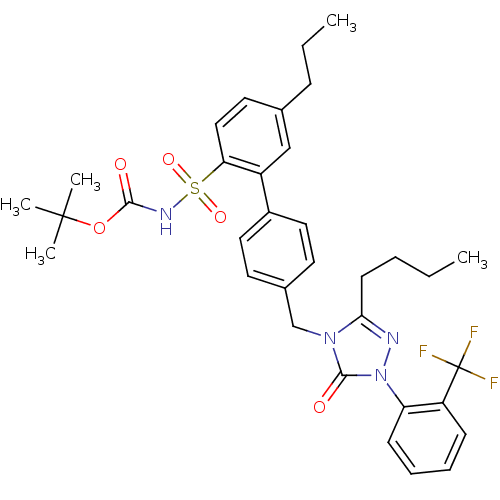BDBM50283764 4'-[3-Butyl-5-oxo-1-(2-trifluoromethyl-phenyl)-1,5-dihydro-[1,2,4]triazol-4-ylmethyl]-5-propyl-biphenyl-2-sulfonic acid(tert-butoxycarbonyl) amide::CHEMBL96554
SMILES CCCCc1nn(-c2ccccc2C(F)(F)F)c(=O)n1Cc1ccc(cc1)-c1cc(CCC)ccc1S(=O)(=O)NC(=O)OC(C)(C)C
InChI Key InChIKey=IKSMFLPUCVAYHQ-UHFFFAOYSA-N
Data 4 IC50
Activity Spreadsheet -- Enzyme Inhibition Constant Data from BindingDB
 Found 4 hits for monomerid = 50283764
Found 4 hits for monomerid = 50283764
Affinity DataIC50: 150nMAssay Description:In vitro inhibitory concentration of the compound against AT1 receptor from human adrenal tissues.More data for this Ligand-Target Pair
Affinity DataIC50: 8.10nMAssay Description:In vitro ability of the compound to inhibit the binding of radioligand 125I[Sar1,IIe8]AII to AT2 receptor from rat midbrainMore data for this Ligand-Target Pair
Affinity DataIC50: 270nMAssay Description:In vitro inhibitory concentration of the compound against AT2 receptor from human adrenal tissues.More data for this Ligand-Target Pair
Affinity DataIC50: 10nMAssay Description:In vitro ability of the compound to inhibit the binding of radioligand 125I[Sar1,IIe8]AII to AT1 receptor from rabbit aortaMore data for this Ligand-Target Pair
